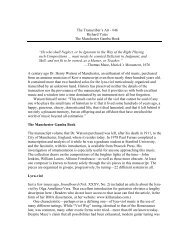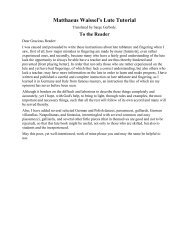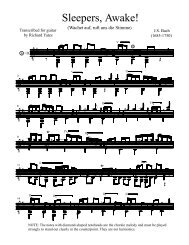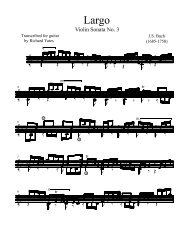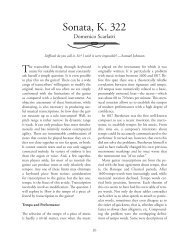The Transcriber's Art - Richard Yates Classical Guitar Transcriptions
The Transcriber's Art - Richard Yates Classical Guitar Transcriptions
The Transcriber's Art - Richard Yates Classical Guitar Transcriptions
You also want an ePaper? Increase the reach of your titles
YUMPU automatically turns print PDFs into web optimized ePapers that Google loves.
In this context, the Pavane is interesting because it seems to be a deliberate exercise inorchestral color, much as Ravel’s Bolero was. <strong>The</strong> main melody repeats in turn on differentinstruments or their combinations. This structure presents both the opportunity and thechallenge for a guitar transcription. <strong>The</strong> guitar, uniquely among instruments, can color theserepetitions with a range of timbres, articulations and dynamics and, in so doing, sustain interestover the extended form. I do not recommend trying to imitate the actual original instrumentsbut, rather, to experiment with different sounds to find the ones that best fit the music, theinstrument, and the player.<strong>The</strong> size of the original ensemble is daunting as you can see in Figure 1. Yet, after sortingthrough the maze of clefs and transposing instruments, a basic structure is revealed that iswithin the reach of the guitar. Figure 2 shows all of the notes of the original score combinedonto only four staves. <strong>The</strong> octave duplications are then eliminated and a more felicitous keychosen. <strong>The</strong> line that combines the first violins and the horns is just a bit more than can bemanaged on the guitar and, because it has no essential harmonic tones not present in othervoices, it was omitted. <strong>The</strong> result is shown in Figure 3—not quite ready for the guitar butcertainly very close. <strong>The</strong> measures in these examples are the densest of the whole piece andwere chosen to show how much reduction is both possible and necessary. A similar procedurewas used throughout the transcription.Flutes, Clarinets,Bassoons, VoicesViolins II,Violas#& ##cœœœ#& ##c ‰œ.œœ.œ œ œœœœœœœ‰œœ.œœ.œœœœœœœœ‰nœnœnœœœœœœœœœœœœ.œ.œ œ œ ‰ œ nœœœœœCellos,Contra-bassesViolins I,Horns? # ## cœœ#& ##c ÓŒnœnœ˙ŒœœŒœœœ ˙ œŒFigure 2ReductionV # cœ . œ œ œ.œ‰ œ œ œ ‰ œ œ œœ Œ œ Œœ n œ œ œ.‰ œ œ œ ‰ œ nœœ Œ œ ŒœœFigure 3




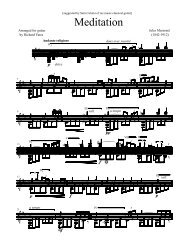
![Finale 2005b - [BWV846-Prelude in C.MUS]](https://img.yumpu.com/43978887/1/190x245/finale-2005b-bwv846-prelude-in-cmus.jpg?quality=85)
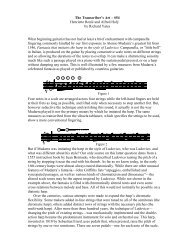
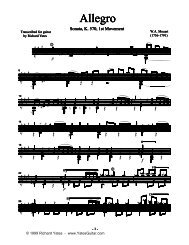

![Finale 2005b - [AirG-TAB.MUS] - Richard Yates Classical Guitar ...](https://img.yumpu.com/37104901/1/190x245/finale-2005b-airg-tabmus-richard-yates-classical-guitar-.jpg?quality=85)

